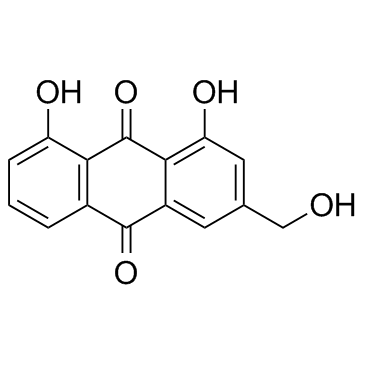芦荟大黄素

芦荟大黄素结构式

|
常用名 | 芦荟大黄素 | 英文名 | Aloeemodin |
|---|---|---|---|---|
| CAS号 | 481-72-1 | 分子量 | 270.237 | |
| 密度 | 1.6±0.1 g/cm3 | 沸点 | 568.8±50.0 °C at 760 mmHg | |
| 分子式 | C15H10O5 | 熔点 | 223-224°C | |
| MSDS | 中文版 美版 | 闪点 | 311.9±26.6 °C | |
| 符号 |

GHS07 |
信号词 | Warning |
|
Correlation between reduction potentials and inhibitions of Epstein-Barr virus activation by anthraquinone derivatives.
Bioorg. Med. Chem. Lett. 18 , 4106-9, (2008) As a continuation of studies using natural and synthetic products as cancer chemopreventive agents, we used cyclic voltammetry to examine the reduction-oxidation potentials of methylated emodin derivatives prepared from emodin in phosphate buffer at pH 7.2. A... |
|
|
In vitro inhibition of Streptococcus mutans biofilm formation on hydroxyapatite by subinhibitory concentrations of anthraquinones.
Antimicrob. Agents Chemother. 51 , 1541-4, (2007) We report that certain anthraquinones (AQs) reduce Streptococcus mutans biofilm formation on hydroxyapatite at concentrations below the MIC. Although AQs are known to generate reactive oxygen species, the latter do not underlie the observed effect. Our result... |
|
|
High-affinity, non-nucleotide-derived competitive antagonists of platelet P2Y12 receptors.
J. Med. Chem. 52 , 3784-93, (2009) Anthraquinone derivatives related to the moderately potent, nonselective P2Y(12) receptor antagonist reactive blue 2 (6) have been synthesized and optimized with respect to P2Y(12) receptor affinity. A radioligand binding assay utilizing human blood platelet ... |
|
|
Expression profile of genes modulated by Aloe emodin in human U87 glioblastoma cells.
Asian Pac. J. Cancer Prev. 15(11) , 4499-505, (2014) Glioblastoma, the most aggressive and malignant form of glioma, appears to be resistant to various chemotherapeutic agents. Hence, approaches have been intensively investigated to targeti specific molecular pathways involved in glioblastoma development and pr... |
|
|
Hypericins and thioredoxin reductase: Biochemical and docking studies disclose the molecular basis for effective inhibition by naphthodianthrones.
Bioorg. Med. Chem. 19 , 631-41, (2011) Cytosolic (TrxR1) and mitochondrial (TrxR2) thioredoxin reductases experience pronounced concentration- and time-dependent inhibition when incubated with the two naphthodianthrones hypericin and pseudohypericin. Pseudohypericin turned out to be a quite strong... |
|
|
Comparison of the cytotoxic activities of naturally occurring hydroxyanthraquinones and hydroxynaphthoquinones.
Eur. J. Med. Chem. 43 , 1206-15, (2008) Seven hydroxyanthraquinone derivatives, 1-7, were isolated from the root of Rheum palmatum (Polygonaceae). Two propionated anthraquinone derivatives, 8 and 9, were synthesized. Four hydroxynaphthoquinone derivatives, 13, 14, 16 and 21, were isolated from the ... |
|
|
Isolation and inhibitory activity against ERK phosphorylation of hydroxyanthraquinones from rhubarb.
Bioorg. Med. Chem. Lett. 16 , 563-8, (2006) Five hydroxyanthraquinone compounds were purified from Chinese medicinal herb rhubarb by microwave-assisted extraction and silica gel column isolation. Their structures were identified by spectroscopic analysis. One of them, emodin, was found to block the ERK... |
|
|
Synthesis and antitumor activity of natural compound aloe emodin derivatives.
Chem. Biol. Drug Des. 85(5) , 638-44, (2015) In this study, we have synthesized novel water soluble derivatives of natural compound aloe emodin 4(a-j) by coupling with various amino acid esters and substituted aromatic amines, in an attempt to improve the anticancer activity and to explore the structure... |
|
|
Anticancer effect of aloe-emodin on cervical cancer cells involves G2/M arrest and induction of differentiation.
Acta Pharmacol. Sin. 28 , 1991-5, (2007) The aim of this study was to investigate the effects of aloe-emodin, a natural compound from the root and rhizome of Rheum palmatum, on the growth of human cervical cancer cells, HeLa.HeLa cells were treated with various concentrations of aloe-emodin for 1-5 ... |
|
|
Aloe-emodin modulates PKC isozymes, inhibits proliferation, and induces apoptosis in U-373MG glioma cells.
Int. Immunopharmacol. 4 , 1775-84, (2004) Aloe-emodin (1,8-dihydroy-3-[hydroxymethyl]-anthraquione) purified from Aloe vera leaves has been reported to have antitumor activity. The objectives of our research were to determine how aloe-emodin regulates the cell cycle, cell proliferation and protein ki... |